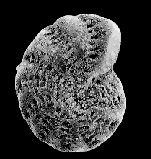
Foraminiferal shell types may be divided into three categories based upon their composition; organic (membranous or tectinous), agglutinated, and calcareous. The agglutinated shells are composed of foreign sediment particles glued together with an organic cement, and the calcareous shells are formed from secreted calcium carbonate. The calcareous shells can be further subdivided into hyaline, porcellaneous, and microgranular types which differ in their calcite crystal arrangement.
Foraminifera are an ideal tool for paleoenvironmental analysis since: 1) they are very abundant in most marine and marginal marine environments with a living population density often exceeding one million individuals per square metre, 2) they have a mineralized shell and thus have a high preservation potential in the sedimentary record, 3) only small sediment samples are needed to obtain fossil populations large enough for statistical treatment, 4) being single celled they respond rapidly to environmental changes, and 5) many foraminiferal species characterize very specific environments.
Due to these characteristics, foraminifera are widely used in the earth sciences for a variety of applications including paleoceanographic research, biostratigraphic analysis in oil exploration, environmental impact of aqua-culture sites, detailed sea-level studies in marine marshes, and paleoclimatology.
As a result of this research, there is a large corpus of environmental information on specific foraminiferal species. This background information makes them a powerful tool for the study of ancient harbors since any harbor's history is closely linked to environmental changes.